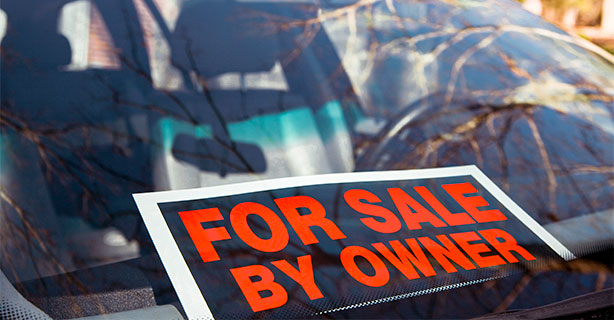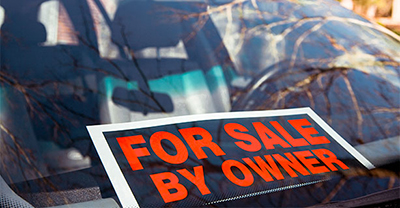What should I know before selling my car?


0 min. read
Selling your car involves several steps, but that doesn’t mean it needs to be complicated. In this guide, we’ll explore the different ways you can sell your car, the information and paperwork you’ll need, and how to complete the sale safely and securely. Explore Dairyland’s cheap car insurance options to find the coverage that fits your lifestyle and budget.
How do you want to sell your car?
There are several options available for you, including selling your car to a dealership, trading it in, selling through an online marketplace or app, selling to a private party, and even selling it for parts.
Sell your car to a dealership
Since selling to a dealership doesn’t require any advertising, negotiating, or waiting for a buyer to show up, this is an attractive option. However, dealerships will typically offer you less money than you could get from selling it privately. If you’re thinking of selling to a dealership, it’s important to do your research to get a solid estimate of your car’s value—and then determine how much you want to prioritize convenience versus getting the most money out of the sale.
Trade your car in
If you’re planning on using the proceeds from the sale of your vehicle to buy a used car, trading in your old vehicle could be the most convenient, hassle-free option. Just remember—like selling directly to a dealership, trading in your old car for a new one will likely get you less money than if you sold it privately.
Sell your car through an online marketplace or app
Online car marketplaces typically provide an instant cash offer based on the make, model, and condition of your car. Always research the online marketplace or app to verify their track record and familiarize yourself with their fees before making a decision.
Sell your car to a private party
Selling to a private party can potentially get you the most money for your car, but it requires increased effort on your part. Selling to an individual buyer typically means you’ll need to advertise your car, negotiate with potential buyers, organize test drives, and deal with a lengthier selling process. However, since you’ll have more control over the sale, you may end up getting a higher price for your vehicle.
Sell your car for parts
Depending on the condition and value of your car, selling it for parts could be a viable option. You can sell individual parts to auto repair shops or list them on online marketplaces like eBay or Craigslist, but as we noted earlier, receiving more money for your sale typically requires more effort on your part.
What to prepare when selling a car
Once you’ve decided how you want to sell your car, you’ll need to prepare a few more things before putting it on the market. Following these steps can help you get the best price for your vehicle and make the selling process run more smoothly.
Gather your paperwork
You’ll need your vehicle title, registration, maintenance records, and any other paperwork specific to your car. When you sell the car, you’ll need to transfer the title to the new owner—and you’ll want to see them sign it.
If you have a loan on your car, you’ll need to pay it off before you can transfer the title. You may also need to provide documentation showing that you’ve paid your loan in full. If you have a loan, contact your lender to find out what steps you need to take to pay off your loan and transfer the title.
Cleaning and repairs
Taking care of the necessary cleaning and repairs can help make your vehicle more attractive to potential buyers. Start by:
Detailing both the interior and exterior of your car
Fixing minor dents, scratches, or other cosmetic issues
Having a mechanic identify mechanical issues you’ll want to resolve before selling the car
Set your price
There are several factors you should consider while determining the value of your car. These include age, mileage, condition, and location. Online tools like Kelley Blue Book, Edmunds, and the National Automobile Dealers Association (NADA) can help you get a realistic idea of your car’s value.
How can I get a good price for my car?
Highlight your car’s features and winning qualities. And remember, when it comes to selling a car, honesty is your best policy—be upfront about your car’s condition and history. By building trust with potential buyers and showing that you have nothing to hide, you can maximize your return on the sale.
Take photos
While some buyers may first see your car in person, many more potential buyers will first see it online or via an advertisement. Take good photos of your car—with interior and exterior views—to attract potential buyers and get a better price for your car. These photos should highlight your car’s best features and look as professional and comprehensive as possible.
Prepare for test drives
While some online platforms will make a cash offer sight unseen, most private party buyers will expect to drive your car before buying it. To prepare for test drives:
Plan on a safe public location to meet—not your home
Bring a friend to the meeting
Be prepared to answer any questions the potential buyer might have (including questions about your title, registration, and insurance)
Gather collateral or a deposit from the test driver to help ensure they return
Most importantly, don’t pressure the buyer. Let them take their time. After all, you were in a similar position when you bought your vehicle—you know it’s a big decision.
What’s the safest place to meet for test drives?
The best place to meet for a test drive is a public parking lot, such as at a shopping center or grocery store. Some police stations allow car sellers to use their parking lot for test drives, but the important thing is that your meeting location is public, open, and safe.
Complete the sale
Once you’ve finished these steps and negotiated a price that both parties are amenable to, it’s time to complete the sale. Start by signing and dating the title, and completing a bill of sale and any other necessary paperwork. Depending on your state’s laws, you may have to go to your local DMV office to transfer the title. Finally, you should receive payment from the buyer. Confirm the funds have cleared before handing over your keys.
What’s the safest way to receive money from selling a car?
Both on and off the road, safety should be your top priority. Especially when dealing with large sums of money, the most secure ways to receive payment are:
Cashier’s check (a check that’s guaranteed by the bank)
Wire transfer (an electronic transfer between banks)
Online payment service like PayPal and Venmo
Don’t accept personal checks or cash. The risks of theft, forgery, or human error aren’t worth the perceived convenience.
What to do after you sell your car
Congratulations! You’ve successfully sold your car. But your journey isn’t over quite yet. Here are a few things to do after the sale is complete:
Contact your insurance company
After you’ve sold your car, contact your insurance company to cancel your policy. This ensures you aren’t paying for insurance on a car you no longer own. Be sure to provide your insurance company with the date of the sale and, if necessary, the contact information of the buyer.
If you’re not planning on buying a car to replace the one you sold, but you still plan on driving occasionally, consider purchasing non-owner car insurance. It can be a cheap alternative to standard auto insurance, and provides liability coverage if you cause an accident while driving someone else’s vehicle.
Buying a used car
If you sold your car because you’re ready for something new, it’s time to start looking for your next vehicle. It helps to know the best places to find a used car—and the best times to look.
Selling your car can seem daunting at first, but with a little preparation and knowledge, it can actually be painless. We wish you luck—and remember, you can get a free car insurance quote when it comes time to insure your next car. Just give us a call at 888-344-4357.
Learn more about how to avoid expensive lapses in coverage—and how you can get car insurance again following a lapse.
Find out how car insurance works and how you can stay safe and compliant behind the wheel.
The general information in this blog is for informational or entertainment purposes only. View our blog disclaimer.
*Data accuracy is subject to this article's publication date.







